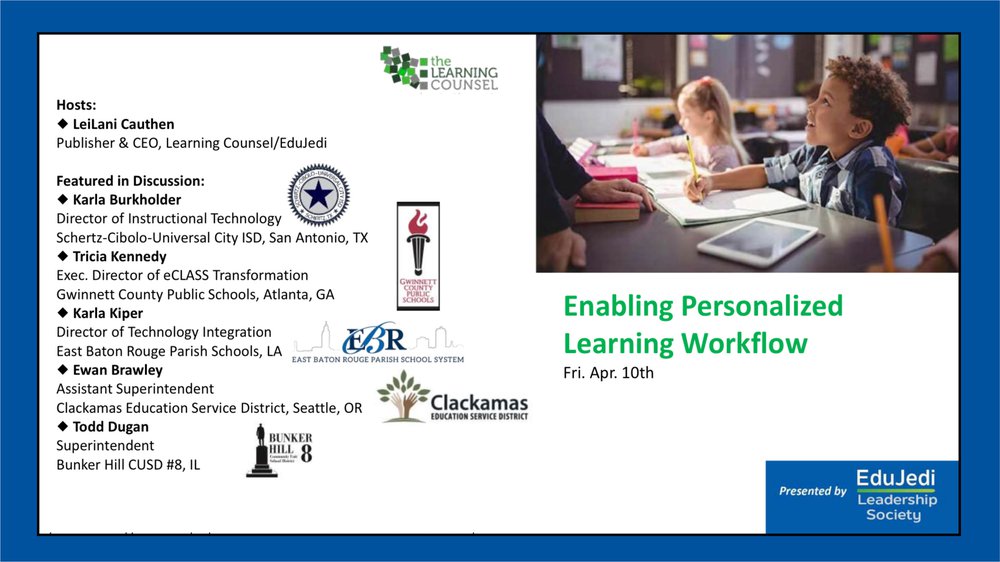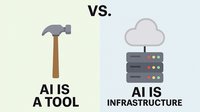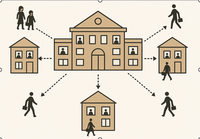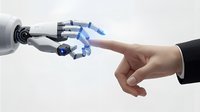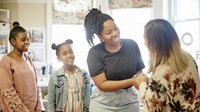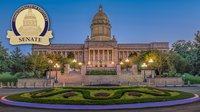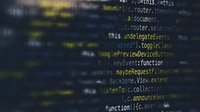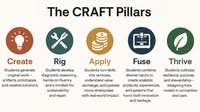Even during the COVID-19 pandemic, learning progress is being made in small ways as well as at-scale. These national education professionals are all leaders in the digital transition, and you’ll be amazed at the ways they have created to continue their progress and move towards personalized workflow learning, enabling their students to grab learning with Uber-like efficiency. In this episode of the Learning Counsel’s Emergency National Virtual Discussions, you’ll hear some very familiar challenges with some new and very actionable solutions.
LeiLani Cauthen, CEO and Publisher at the Learning Counsel asked, “What do we mean by enabling personalized workflow learning as everything comes together? Let me just give you a little insight on that. This is the software model architecture that most of you have seen as we came to your physical locations during the course the last couple of years.
“And it's just basically a map of all the things that are in the market. Your websites, your portals, they're at the top. And then on the right side you've got your ID management and single sign on your security underbelly, your data warehousing, your middleware, your analytics. And then you've got these framework management systems, student information systems, learning management systems. And then you're underneath that is how you're storing, how you're routing things, your networks, your hardware, and then you've got this Wild West of content resources, which might be anything from some single document or single video that somebody's throwing out there, or it might be a whole app that teaches math and basically guides the students forward and in module after module or language or it's a full repository, it's a full library of books. All those things are mapped normally at the teacher level, from guidance on the curriculum maps coming down from the top.
Now districts are realizing they need a little bit more rules around things because it's getting to be kind of crazy out there. But when an outside workflow system is indicating that workflow, it backwards-engineers in when you would have a teacher intersect to need.”
According to Todd Dugan, Superintendent at Bunker Hill CUSD #8, “Personalized learning has been a focus of ours in a push in most recent years. And we were really gaining momentum and now it seems like it ground to a halt. As far as actual movement towards implementing more personalized learning because of the necessity, we have 18 percent of our families without broadband access. And so like a lot of districts, we were struggling with the workflow being whatever we can online virtually and then also taking into account our unconnected families. One of the caveats that we have implemented in our district is that if a student is unconnected, the work that they receive to complete should be identical and equitable to our connected students. My hope is that when this is all over with and we go back to school physically, that the lessons that we have learned from this, show personalized workflow learning as truly what personalized learning could be, especially digitally, or even as remote distance learning.”
Karla Burkholder is the Director of Technology at Schertz-Cibolo-Universal City ISD. According to Burkholder, “Our teachers have been thrown into this idea of remote or virtual learning and I have to tell you they've adapted very well. But that said, we didn't have the training for it, you know, it all happened so quickly. But I have to say that my district didn't panic, and we took the time to develop a remote learning plan and a remote learning guide for teachers and for families. We're not trying to replicate exactly what happens in the classroom because you can’t; if you've got a house full of two, three or four kids, you can't expect them to all be working exactly like they do in school if they've only got one or two devices.
“We really needed people to think through and understand the logistics of what's going to be happening in homes when kids have to stay home to learn. We do have kind of a mixed approach to that. We have digital and we also have, because there are parents that don't have computers or Internet connectivity, some paper copies. We did distribute devices to families that requested them and that's worked well. In our remote learning guide, we've addressed dyslexia and special ed and the professional development part teachers.”
Tricia Kennedy, Executive Director of Instructional Development and Support at Gwinnett County Public Schools has all the complexities of an extremely large district. “Our current status, we've been fully online for three,” said Kennedy. “And we know we're going through May 20th because our governor has closed schools through the rest of the school year. We've been really shocked and really surprised and thrilled at how well the three weeks have gone. But we didn't get here overnight. we've had several years of developing our ecosystem and we didn't realize it at the time, but we had practice days the last two years when we had snow days. So, the last two years we had days where we were fully online, but because of being closed for inclement weather and we didn't have any clue that we were practicing fortwo months of being online at the time.
“But we were, and we have had the advantage of having a lot of PD for our teachers over the last several years making tech a part of our instruction. I'll tell you a little bit about our ecosystem and how we developed that. The ultimate goal being more and more personalized learning, but it's been iterations. It's still a process. We started with some very definite goals in mind. We wanted technology to really enhance and transform instruction, but to get there we knew we needed to do a couple of things first. And that was first of all to create a one stop shop for teachers and students and then to have a space for our teachers and students to have virtual classrooms.
“Our student and our teacher portals now have just a variety of resources that over the years we curated and we've been pushing everything in. We have digital textbooks. They come in through our learning object repository and then can be very easily linked by teachers. They can search in that learning object repository and easily link it into their course pages in our level LMS.”
Karla Kiper, Director of Technology Integration at East Baton Rouge Parish School System said, the impact of COVID-19 in Louisiana like so many other things has hit hard among some of our most vulnerable populations. Here in East Baton Rouge we have between 75 and 80 schools, around 40,000 students and around 3,500 teachers. We were making some really nice gains academically in our schools and also making nice gains in terms of using our technology. Complicating the task of continuing or providing continuity and instruction and access to learning opportunities is the fact that in Louisiana we have about 30 percent of our population that lack access to the Internet. We are looking at several options right now, including deploying the school buses in the community that will have a range of Wi-Fi and trying to boost our Internet signals coming from our school buildings so that we can cover more areas of the community.”
Ewan Brawley is the Assistant Superintendent at Clackamas Education Service in Oregon. His service district represents suburban Portland as well as more rural areas of Clackamas County. Brawley’s role is to support his districts, and he says “We've tried to make space to really think about what is the essential distance learning organizational infrastructure so that we can support districts with and how can we help them think about roles that they had within their system. Thinking about quality assessment and feedback, what does that look like? And distance learning context, really thinking deeply and we're getting an increasing volume of requests to have a help desk for families. We had a help desk already set up in our County for students and staff, but that family support in this particularly for elementary parents has been a big thing that we're trying to stand up right now in our County. Most of the districts have leaned towards asynchronous distance learning with some exceptions. We think about things like equity and where you have multiple students that need to access learning in a household but don’t necessarily have multiple devices.”
Watch the video
Amid the issues of the COVID-19 pandemic and mandatory school closings, these education professionals are finding ways to solve challenges and move towards personalized learning while envisioning a workflow enabled personalized learning environment. It’s heady stuff, and these leaders share their successes, warts and all. You’ll want to watch this virtual discussion. It’s full of useful strategies you can take home to your own school or district and implement right away.

